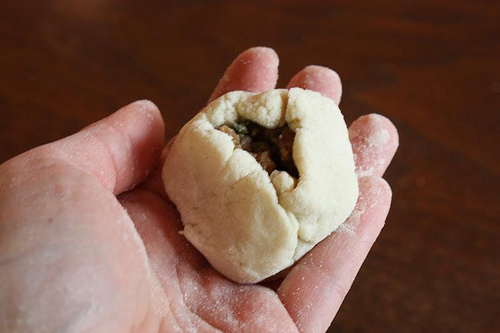
Baked gluten-free buns are less tricky to make than steamed ones because you bake them in the same pan that you let them rise in. The result looks like giant macarons or pfeffernusse – low domes. They’re firmer and denser than your typical baked bao, but they are tasty in their own right.
Making a flavorful filling is important because it stamps the bao with extra texture and savor. I used char siu pork for the ones pictured above. Other filling options are mentioned below for savory and sweet buns. If you’re super sensitive to gluten, you’ll have to figure out alternatives for certain Asian ingredients used in the fillings. See this post for guidance on gluten-free Asian ingredients.
Gluten-Free Baked Bao
Makes 16
1 recipe Gluten-Free Bun Dough (see Gluten-Free Bun Trilogy post)
1 ⅓ cups bao filling (char siu, curried chicken, vegetable and tofu for savory buns; red bean paste and mung bean paste for sweet buns; see Asian Dumplings, pages 100-102, 203-204), or chicken and shiitake filling
1 egg, beaten
2 tablespoons honey diluted with 1 tablespoon water
1. Line 1 large or 2 medium baking pans with parchment. Work with half the dough at a time. Amply dust the work surface with about 2 tablespoons of gluten-free flour. Put half of the dough on top and gently shape and roll into a thick 8 to 10 inch log. Cut it crosswise into 8 pieces.
2. For each bun, take a piece of dough, gently pat it into a ¼-inch-thick round (2 ½ to 3 inches wide). Center 4 teaspoons of filling on top, then nudge and pinch the dough together to close it up around the filling and form a ball. This is nearly closed up:

Place the ball on the parchment paper, seam side down. Repeat to make more before attacking the other half of dough.
3. Tightly cover the pan(s) with plastic wrap, then slide them into the oven. Turn on the light to keep the buns warm. Let rise for 60 minutes.
During the final 15-20 minutes, remove the pans from the oven and place them atop the stove to stay warm. Position a rack in the middle of the oven and preheat to 350F.
4. When rising time is up, brush the buns with egg, then bake for 30 to 35 minutes, until golden. Remove from the oven, let the buns rest for 5 minutes, then brush honey on the buns. (If you are baking in advance, reheat the buns in a 350F oven for 5 to 6 minutes or microwave oven, until hot. Then cool and brush on the honey glaze.)
Let the buns cool for a few minutes and soften from the honey before eating.
Related posts
- Gluten-Free Bun Trilogy: Dough Recipe
- Steamed Gluten-Free Bun (Bao) Recipe
- Gluten-Free Pot Stickers: Recipe Trial & Dough 3 (sorghum, sweet rice, and tapioca starch dough)
- Gluten-Free Pot Stickers: Recipe Trial & Dough 2 (millet, sorghum, tapioca, and potato dough; includes tips on working with GF dumpling dough)
- Gluten-free Pot Stickers: Recipe Trial 1 (on Asiandumplingtips.com)
- Guide to Building an Asian Dumpling Pantry
- Tolerance Test: Are Gluten-Free Asian Ingredients for You?

















Moncler Coats says
Anyway, I exclude The Wire for the same reason that Time decided to start their list of the century's best novels in 1923. It's more fun that way.
http://www.monclerjacketsfactorys.com
Weber Grills says
Wow these look so good, almost like some kind of mince pie. I guess you could put such a filling inside of these. I have just brought some mince pie ice cream which would go really nicely. Yum yum
mikefast says
Yum Yum good recipe....
research paper says
wow this was great in breakfast, hope you can post more breakfast foods..
Cheers
Delicious
Bucky says
This is both srteet smart and intelligent.
Mr. Cooking Grill says
Baked Buns Your so yummy! 🙂
marlon says
That buns is best for breakfast!
Nickle says
want to try it at home and i can't wait 😀
George Zeller says
Good Morning, Perhaps you can help us, or direct us to where we might be able to find this recipe; Since we got home we have been searching for a recipe for Haitang Gao or Hai Tang Gao (海棠糕) also known as Begonia Cake that was created in the Qing Dynasty.
Recently, we were in China for 26 days. While we were at "Old Street" in Shanghai we enjoyed some of the street food. In particular, we had several Hai Tang Gao (海棠糕) at the first stall over the Qibao Old Street Bridge, they were absolutely delicious. We understand the filling was Red Bean Paste. We enjoyed several sweet buns filled with Red Bean Paste in a stall by Qibao Bridge. We found the stall for these Hai Tang Gao (海棠糕) when surfing the internet and in google typed –Old Street Pictures Shanghai. And found the following so we were able to find this vendor and she was very happy when I showed her this picture.
hai tang gao.jpg
Hai Tang Gao (海棠糕)
This stall, close to the Qibao bridge, sells the best hai tang gao on the entire street.
These baked cakes (RMB 2) have a generous red bean filling, a slight crackle from molten caramel on the crust and a soft, pancake-like texture.
The humble hai tang gao is plain looking, resembling a rustic pot pie, but it is the most iconic and the most delicious of all the qi bao rice cakes (七宝糕).
My favorite comes from the stall closest to the Qibao bridge, on the south side.
We would very much like to get a recipe to be able to make Hai Tang Gao (海棠糕) at our home in Clearwater, Florida USA. We would greatly appreciate your help. Hope you can help us or give us direction to find a recipe. Look forward to hearing from you.
Thank you,
Best Regards,
George Zeller